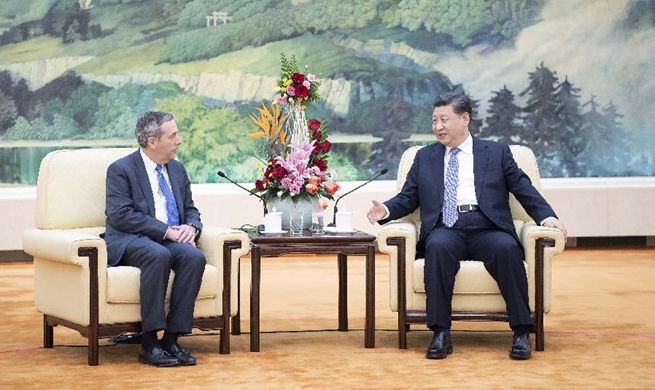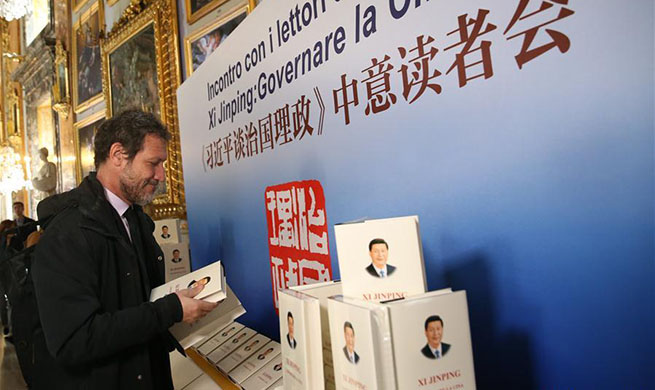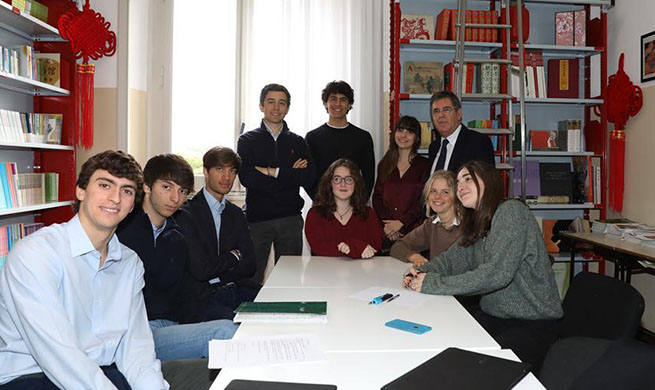WASHINGTON, March 20 (Xinhua) -- The U.S. Federal Reserve on Wednesday left interest rates unchanged after concluding a two-day policy meeting, in a move that met market expectations and reflected the central bank's patient approach regarding monetary policy changes.
The Fed also announced that it will conclude the reduction of its aggregate securities holdings at the end of September.
KEEPING INTEREST RATES STEADY
In support of the goals of fostering maximum employment and price stability, the Federal Open Market Committee (FOMC) decided to maintain the target range for the federal funds rate at 2.25 percent to 2.5 percent, the central bank said in a statement.
The FOMC, the Fed's monetary policymaking body, continues to view sustained expansion of economic activity, strong labor market conditions, and inflation near the Committee's symmetric 2 percent objective as the most likely outcomes, said the statement.
"In light of global economic and financial developments and muted inflation pressures, the Committee will be patient as it determines what future adjustments to the target range for the federal funds rate may be appropriate to support these outcomes," it said.
Addressing a press conference, Fed Chairman Jerome Powell said he and his colleagues believe that the central bank "should be patient in assessing the need for any change in the stance of policy."
"Patient means that we see no need to rush to judgment," he said. "It may be some time before the outlook for jobs and inflation clearly calls for a change in policy."
Rate projections released after the policy meeting showed that 11 of the 17 officials who participated in setting interest-rate policy didn't predict any rate hikes whatsoever this year, while the rest of the six participants foresaw between one and two increases. In December, the median projection for the number of rate hikes this year was two.
Asked by a reporter if there will be a "big cut" in interest rates in the future, Powell responded by saying that the data the Fed is seeing is "not currently sending a signal that we need to move in one direction or another."
The median of responses in the March 13-15 Bloomberg poll predicted one hike by the Fed in September, with the upper end of the target range for the federal funds rate touching 2.75 percent. Economists said that would likely mark the peak of this hiking cycle.
Edwin Truman, a nonresident senior fellow at the Washington-based Peterson Institute for International Economics, said on Tuesday that he predicts there will be at least one more hike, "probably this year." He said he agrees that the hiking cycle is nearing the peak, "but you don't know where the peak will be."
In an interview with Xinhua, Truman estimated that the rate's target range at the end of this cycle would probably reach somewhere between the current levels and 3.25 percent.
"Not far from where we are," he said. "Whether (the upper end is) three or three and a quarter ... it depends on the evidence, and we don't know what that evidence is going to be."
"MODEST SLOWDOWN" OF U.S. ECONOMY
With respect to the U.S. economy, Powell told the press conference that the individual FOMC participants' views "point to a modest slowdown with overall conditions remaining favorable" this year.
The FOMC members "now see 2019 growth at roughly 2 percent, with the unemployment rate remaining below 4 percent," and core inflation rate, which omits the volatile food and energy prices, remains close to 2 percent, he added.
Powell said Fed officials are "also very mindful" of what the risks are, citing examples such as the slowing global growth, uncertainties related to Britain's exit from the European Union, as well as the ongoing U.S.-China trade talks.
Truman said there is "probably enough strength in the U.S. economy," adding that the chance for a rate hike in early 2020 is less than 50 percent. "I would be surprised that things go beyond that."
Speaking of China coping with the Fed's monetary tightening, Truman said the country's recent fiscal and monetary policies are serving the economy well, adding that he thinks China can handle its economy "reasonably well."
"They've done a pretty good job over the years," Truman said.
On the trade disputes between Beijing and Washington, the expert said the issues would not have too much of an impact on the bigger picture of the two economies.
"The trade issues in and of themselves are not dramatic, because they are relatively small moves in terms of the total size of the Chinese economy or the U.S. economy," Truman said, adding, however, that the tension has introduced a level of uncertainty, affected investment decisions, and had some impact on global slowdown.
ENDING BALANCE SHEET RUNOFF
In a separate statement on Wednesday, the Fed said it intends to conclude the reduction of its aggregate securities holdings at the end of September. The process, known as Balance Sheet Normalization, started in October 2017.
The central bank intends to slow the reduction of its holdings of Treasury securities by reducing the cap on monthly redemptions from the current level of 30 billion U.S. dollars to 15 billion U.S. dollars beginning in May, according to the statement.
The Fed's asset portfolio, as a consequence of the quantitative easing policy following the 2008 financial crisis, amounted to about 4.5 trillion dollars when the central bank began to gradually reduce it two years ago.
Powell said the balance sheet will be of a size of approximately 17 percent of gross domestic production (GDP) around the end of this year, down from 25 percent of GDP at the end of 2014. In dollar terms, Powell added, "it looks like it'll be a bit above 3.5 trillion."
The Fed, Powell said, does not regard its Balance Sheet Normalization Program as a monetary policy tool. "We still think of the interest-rate tool as the principal tool of monetary policy."
"We think of ourselves as returning the balance sheet to a normal level over the course of the next six months. We're not really thinking of those as two different tools of monetary policy," he said.













